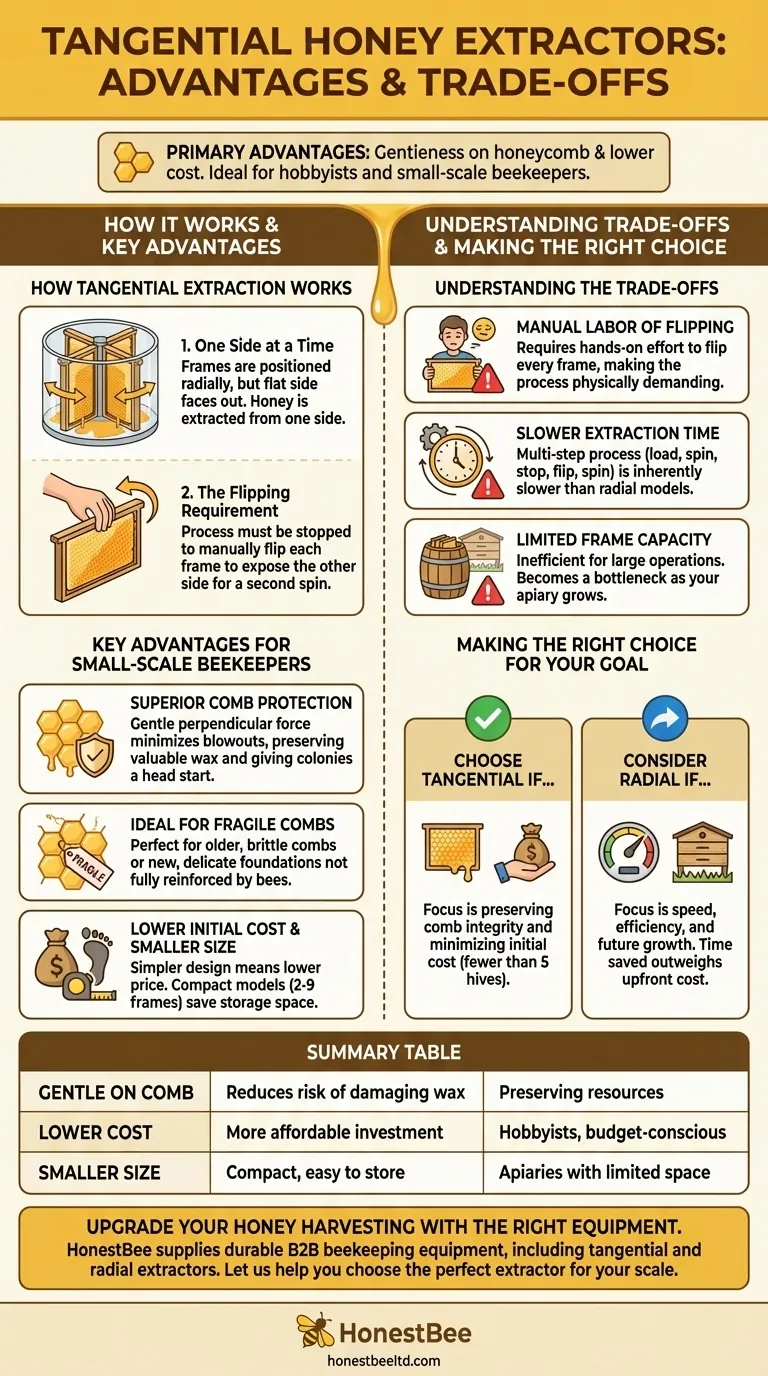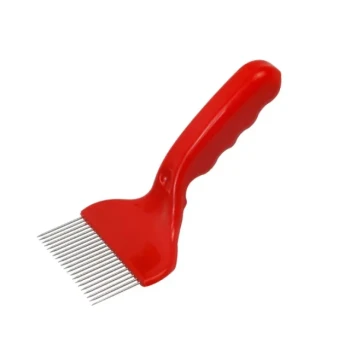In short, the primary advantages of a tangential honey extractor are its gentleness on the honeycomb and its lower cost. By extracting honey from only one side of the frame at a time, it applies less stress, significantly reducing the risk of damaging old, fragile, or freshly drawn-out comb. This makes it an excellent, budget-friendly choice for hobbyists and small-scale beekeepers.
The decision to use a tangential extractor comes down to a fundamental trade-off: you gain superior comb protection and a lower initial investment in exchange for a slower, more labor-intensive extraction process.

How Tangential Extraction Works
To understand the benefits of a tangential extractor, you first need to understand its mechanics. It operates on a simple, direct principle.
The "One Side at a Time" Method
A tangential extractor positions the frames like spokes in a wheel, but with the flat side of the comb facing outwards. When the extractor spins, centrifugal force pulls the honey straight out from that one side.
The Flipping Requirement
Because honey is only extracted from the outward-facing side, you must stop the process halfway through. You then manually flip each frame to expose the other side and spin it again to complete the extraction.
Key Advantages for the Small-Scale Beekeeper
The design of a tangential extractor provides distinct benefits, especially for those managing a small number of hives.
Superior Comb Protection
This is the most significant advantage. The force is applied directly perpendicular to the comb's surface, which is much gentler than the force in other designs. This minimizes blowouts and damage.
Bees expend significant energy and resources building wax comb. By preserving it, you give your colonies a massive head start for the next nectar flow, as they can immediately start filling cells instead of rebuilding them.
Ideal for Fragile Combs
The gentle action makes tangential extractors perfect for delicate combs. This includes older, more brittle combs or new foundation that has not yet been fully reinforced by the bees.
Lower Initial Cost and Smaller Size
Tangential extractors are typically simpler in design, making them less expensive than their radial counterparts. They also tend to be smaller, holding between 2 and 9 frames, which is ideal for beekeepers with limited storage space.
Understanding the Trade-offs
While effective, the tangential design has clear limitations that you must consider. It is not the right tool for every operation.
The Manual Labor of Flipping
The biggest drawback is the need to flip every frame by hand. This makes the entire process more hands-on and physically demanding compared to a "set it and forget it" radial model.
Slower Extraction Time
The multi-step process—load, spin, stop, flip, spin again—is inherently slower. Extracting a full super can take considerably longer than it would in a radial extractor of a similar size.
Limited Frame Capacity
Most tangential extractors are designed for small-scale use, with a capacity that is inefficient for anyone managing more than a handful of colonies. The time required for extraction quickly becomes a bottleneck as your apiary grows.
Making the Right Choice for Your Goal
Selecting an extractor depends entirely on your priorities and the scale of your beekeeping operation.
- If your primary focus is preserving comb integrity and minimizing initial cost: A tangential extractor is the ideal choice, especially if you have fewer than five hives.
- If your primary focus is speed, efficiency, and future growth: You should strongly consider a radial extractor, as the time saved will quickly outweigh the higher upfront cost.
Ultimately, choosing the right tool is about aligning your equipment with the specific needs of your apiary.
Summary Table:
| Advantage | Key Benefit | Ideal For |
|---|---|---|
| Gentle on Comb | Reduces risk of damaging fragile or new wax. | Preserving colony resources. |
| Lower Cost | More affordable initial investment. | Hobbyists and budget-conscious beekeepers. |
| Smaller Size | Compact and easy to store. | Apiaries with limited space (2-9 frame capacity). |
Upgrade Your Honey Harvesting with the Right Equipment
Whether you're a hobbyist focused on comb preservation or a commercial apiary prioritizing efficiency, having the right extractor is key to a successful season. HONESTBEE supplies durable, high-performance beekeeping equipment, including tangential and radial extractors, to commercial apiaries and distributors through our wholesale-focused operations.
Let us help you choose the perfect extractor for your scale and goals. Contact our team today for expert advice and competitive pricing on all your beekeeping supply needs!
Visual Guide

Related Products
- HONESTBEE 3-Frame Manual Acrylic Honey Extractor
- HONESTBEE 72 Frame Industrial Electric Honey Extractor for Beekeeping
- 2 Frame Stainless Steel Manual Honey Spinner Extractor for Beekeeping
- Stainless Steel 3 Frame Manual Honey Extractor Spinner for Bee Honey Extraction
- 24 Frame Honey Extractor Commercial Radial Honey Frame Extraction Machine
People Also Ask
- What machines are needed in beekeeping besides basic tools? Scale Your Honey Harvest Efficiently
- How do you manually extract honey? Choose the Best Method for Your Hive
- What is a fun and easy alternative to using a honey extractor for harvesting honey? Try the Crush and Strain Method
- What equipment is used for honey harvest? Essential Tools for Every Beekeeper
- What is the most common method for cleaning a honey extractor? Protect Your Honey & Equipment



















